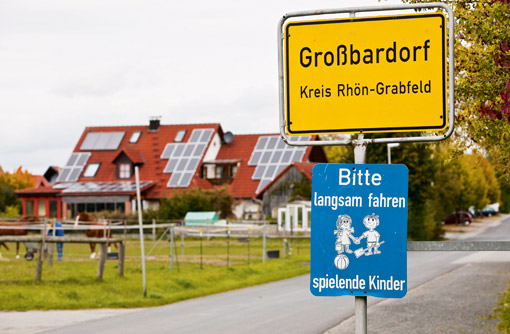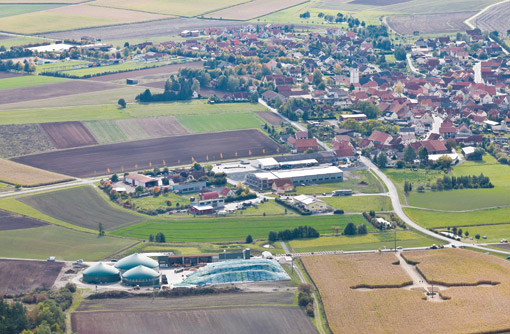German renewables villages in the spotlight

Renewables villages are an up-and-coming concept being adopted by farmers and villagers across Germany. Scott Casey visited the Bavarian town of Großbardorf to witness the idea in action.
With about 950 citizens Großbardorf, in north eastern Bavaria, is a comparatively poor community, suffering underinvestment by business and the state as a result of its proximity to the old Cold War border between East and West.
But when local mayor Josef Demar made the decision to rebuild part of the town’s ageing road network, arable and livestock farmer Mathias Klöffel saw an opportunity to invest in the community, save villagers money, create business opportunities and help farmers turn a profit.
Mr Klöffel’s plan was to build a biogas plant, fuelling it using locally grown maize and slurry from pig and dairy operations, generating electricity and providing heating through a district-heating network to be built under the new streets.
“In Bavaria there are many biogas plants that produce electricity but few that use their potential to generate heat,” Mr Demar said.
“Before you build one you need to think about the heating. If you miss out on using the heating you’re losing a lot of energy.”
In total 44 farmers invested approximately €10,000 (£8,547) each to construct the 0.6MW plant which now generates electricity and heat for 110 homes in the village. Drawing on a solar photovoltaic array built in 2003 and the biogas plant, Großbardorf produces 380% of its electricity requirements.
The biogas plant has also attracted businesses to the area. A factory producing machinery for the automotive construction industry opened in an industrial area near the plant and a house painter and other smaller companies have moved in.
These companies provide more than 120 extra jobs for the village and the region.
“The factory owner has saved a lot of money coming here,” Mr Demar said.
“Otherwise he’d have to buy a boiler and that would have cost about €100,000 (£85,470) but with the district heating network it only cost him €75,000 (£64,102) for the set-up.”
It’s not just councillors and farmers taking pride in their achievements either – the German Federal Ministry of Agriculture recognised the town in 2012 as one of the nation’s three best renewable energy villages with the Bioenergiedörfer award presented at the EuroTier agricultural show in December last year.

Co-operative success
The village’s biogas plant is operated along a co-operative model know as a “Friedrich Wilhelm Raiffeisen Energy Cooperative”, named after the man who founded rural credit unions in mid-19th-century Germany.
Currently, 31 different co-operatives based on the model are registered in Germany. Through them, rural communities are able to access a manual containing templates and business plans for a variety of renewable energy projects as well as software for managing the enterprise.
Access to credit is usually the sticking point for these sorts of operations but, Mr Klöffel says, in establishing a co-operative, finance has been the least of his concerns.
“When you have many farmers, money is not a problem,” he says.
“With 40 farmers all putting in €10,000, that’s €400,000, and the rest comes from the bank. So we begin every project like this, with many villagers or many farmers.”
In the UK, it is estimated there are more than 40 co-operative energy projects in operation with a little more than £16m invested. But in Großbardorf alone €15m (£12.82m) has been invested since 2003.
And across Germany, on the whole, almost €1bn is invested in more than 500 co-ooperative renewables projects, most involving farmers.
Mr Klöffel says the lesson from their project is that farmers need to work together more often and that co-operation is not as hard as they might think.
“I can’t work on my farm and in the biogas plant and on the photovoltaic array, though in a co-operative I can do all these things by working together with other farmers,” he said.
“It is impossible to carry the financial risk and undertake all the work. But in a group it is much easier, you can share the load.”
From here the co-operative has even more ambitious plans such as planting a hazelnut orchard, in an effort to replace imported hazelnuts with home-grown, a biogas-heated tomato farm, again to replace imported tomatoes, and a fish farm.
And elsewhere in the state other co-operatives of farmers and villagers are starting their own renewable energy projects.
Nearby another Friedrich Wilhelm Raiffeisen co-operative is about to start construction on the state’s largest wind farm with 20 turbines involving 800 landowners across 700ha drawing on the financial resources of six villages.
“People should invest their money in their local region, not overseas but in the village. But they need projects and business with which to do this, so we need to provide these things for people to invest in,” says Mr Klöffel.
“The money of the village, for the village.”
The biogas facility
The biogas facility is situated on the eastern fringe of the village with its own storage area for silage, underground tanks for slurry and a nearby industrial park powered and heated by the plant.
For the district heating network, water is warmed to 40C by the ambient heat of the plant alone (in a normal electric-only biogas facility, 40-60% of the energy generated by the plant is lost as heat) then its temperature is boosted up to 80-85C by a heating system powered on electricity generated from burning the biogas.
It is then pumped into the 6km-long district heating network, heating 110 homes, schools, and church buildings in the village.
When temperatures drop below -8C in winter, the heating system co-generates with a wood and oil burning generator.
The plant has a worker at the biogas facility about 30-hours a week.
- 0.6 MW facility
- Built by a co-operative of 44 farmers
- Heat distributed to 110 houses via an underground district heating network
- Households pay €5,000 (£4,273) to connect to the network and 9c/kW for heating
- Total investment of €3.7m (£3.1m) with €440,000 (£376,068) in initial capital investment from farmers
Solar photovoltaic array
The first project of the co-operative, the solar array, attracted the most interest from the local community in 2003 and proved the co-operative organisational model could work. The facility alone produces enough power to supply the whole village of Großbardorf.
- 1.8 MW installation built in 2003
- Built by a co-operative of 50 villagers and 50 people from the region.
- Total investment €7.6m (£6.49m)
Read more renewables news on our Farm Energy page
